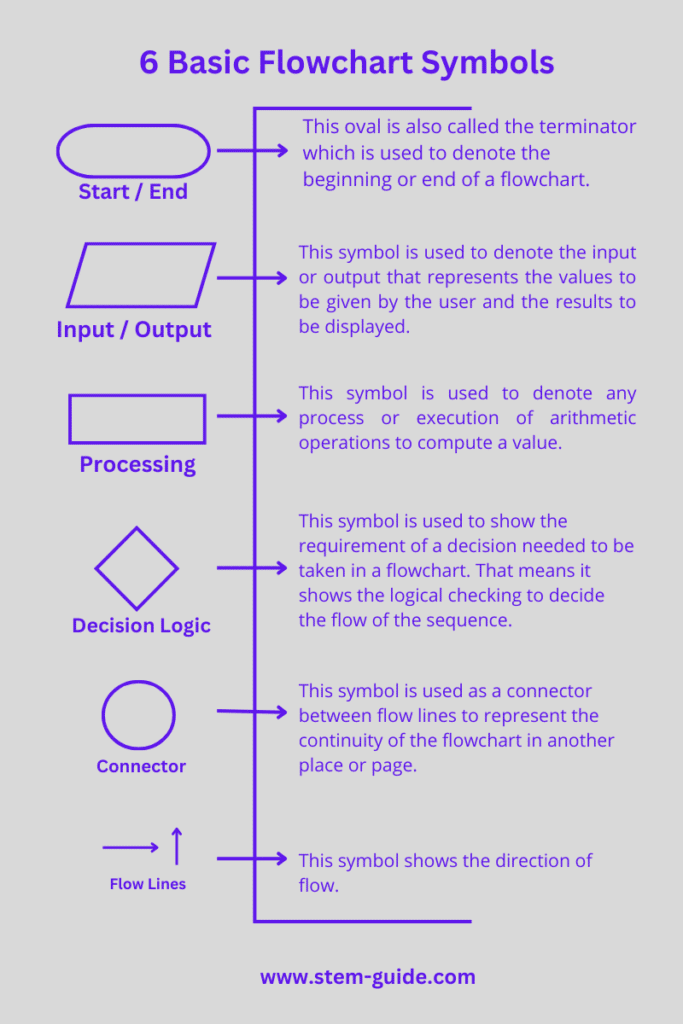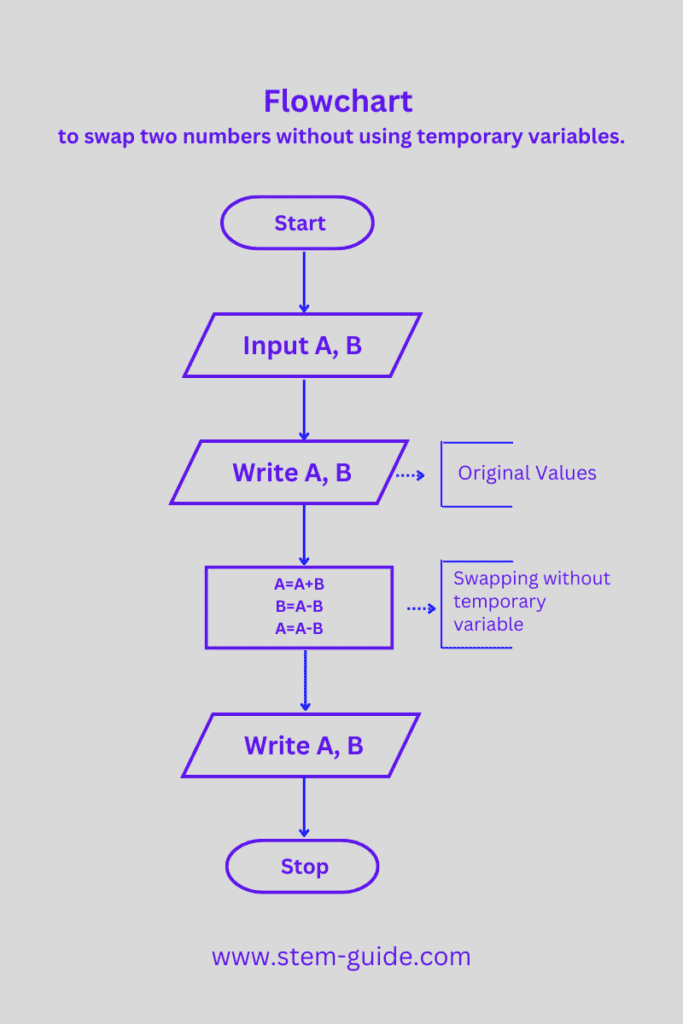What is Flowchart? How to Draw a Flowchart?
Flowchart: A pictorial representation of a step-by-step solution to a given problem. Here is the complete tutorial on the flowchart listed below.
I can elaborate on it as the Flowchart is a symbolic or diagrammatic representation of an algorithm. It uses several geometrical figures to represent the operations, and arrows to show the direction of flow.
It’s a type of diagram created using predefined, meaningful shapes to denote the process flow like Start, End, Input, output, process, etc.
So, the flowchart is a pictorial representation of the sequence of operations necessary with a computer. The first formal flowchart is attributed to John Von Neuman in 1945.
Flowchart – How to Read it?
To read a Flowchart, you need to follow the direction from left to right and top to bottom. Each symbol used to create a flowchart have its own meaning. As the oval shape denotes both the starting and end of the flowchart.
A flowchart can be used for different purposes but here we will discuss the use of a flowchart to explain the steps of computer programs. In such cases, it will show the sequence of instructions in a program or subroutine.
The symbols used in constructing a flowchart are simple and easy to learn. These are very important planning and working tools in programming.
The purpose of the flowcharts is given below:
- Provide Better Communication: these are excellent means of communication. The programmers, teachers, students, computer operators, and users can quickly and easily get ideas and descriptions of algorithms.
- Provide an Overview: A clear overview of a complete problem and its algorithm is provided by the flowchart. The main elements and their relationship can be easily seen without leaving important details.
- Help in algorithm design: The program flow can be shown easily with the help of a flowchart. A flowchart can be easily drawn in comparison to writing a program and testing it. Different algorithms (for the same problem) can easily experiment with flowcharts.
- Check The Program logic: All the major portions of a program are shown by the flowchart, precisely. So the accuracy of the logic is maintained.
- Help in coding: A program can be easily coded in a programming language with the help of a flowchart. All the steps are coded without leaving any part so that no error lies in the code.
- Modification becomes easy: A flowchart helps in the modification of an already existing program without disrupting the program flow.
- Better Documentation Provided: A flow chart gives permanent storage of program logic pictorially. It documents all the steps carried out in an algorithm. A comprehensive, carefully drawn flow chart is always an indispensable part of the documentation of the program.
Symbols used in Flowchart
There are only a few symbols available that are used to create flowcharts to show necessary operations. Each of these symbols has a specific meaning and function in a flowchart. These symbols are standardized by the American National Standards Institute (ANSI).
Rules to use flowchart symbols;
- Use the symbols for their specific purpose.
- Be consistent in the use of symbols
- Be clear in drawing the flowchart and the entries in the symbol.
- Use the annotation symbol when beginning a procedure.
- Enter and exit the symbol in the same way.
6 Basic Flowchart symbols for creating a Flowchart
There are many symbols used for creating a flowchart but If you are a beginner and want to learn about flowchart symbols. Then you can start with the six most important flowchart symbols which are basically used to draw simple flowcharts.
Here are the six basic flowchart symbols:
- The Oval: This oval is also called the terminator which is used to denote the beginning or end of a flowchart.
- The Rhombus: This symbol is used to denote the input or output that represents the values to be given by the user and the results to be displayed.
- The Rectangle: This symbol is used to denote any process or execution of arithmetic operations to compute a value.
- The Diamond: This symbol is used to show the requirement of a decision needed to be taken in a flowchart. That means it shows the logical checking to decide the flow of the sequence.
- The Circle: This symbol is used as a connector between flow lines to represent the continuity of the flowchart in another place or page.
- The Arrow: This symbol shows the direction of flow.

What are the different Types of flowcharts?
Flowcharts are used by different people for many different purposes. But here in this article, I am talking about the flowcharts that system designers and programmers used in developing algorithms.
So, there are mainly three types of flowcharts that will be covered.
- System Flowcharts
- Modular Program Flowchart
- Detail Program Flowcharts or Application Flowcharts
System Flowchart:
System flowcharts are the flowcharts that are basically used by system engineers and system analysts to inspect, analyze, and review a system. It plays a vital role in executing a systematic investigation to analyze a system with different symbols to make it easier for the overall study of the system.
Again, we need to understand the definition of a system before knowing about a system flowchart.
A system is a group of interrelated components tied together according to a plan to achieve a predefined objective.
So, the system flowchart is used to represent the elements and characteristics of a system graphically. With a system flowchart, it becomes easy to visually explain the structure and relationship between the different elements of a system with the flowchart.
A system analyst uses the system flowchart to analyze and design various systems.
While analyzing a system, a system engineer or an analyst needs to consider the different stages of a system are:
- Problem Recognition
- Feasibility
- System Analysis
- System Design
- Implementation
- Evaluation
A system flowchart helps engineers and analysts to conduct a systematic study following the above-mentioned stages and visually represent the findings.
Based on the study they suggest whether there is a need for any alternative solution for an existing system or whether an entirely new system is required.
Therefore, a system flowchart is important for every designer and analyst to document a system with precisely drawn flowchart symbols.
Modular program flowchart:
A modular program flowchart defines the logical steps of the input, output, and processing of the information of a specific program. This is also known as a structured program where there is a collection of small and independent modules that work independently for different procedures.
Each module or unit is written independently to perform specific operations. This type of module does not perform operations in a detailed way but includes the relationship and order in which the processes are to be performed.
Modular program flowcharts are also known as block diagrams. The main advantage of this flowchart is to help programmer to concentrate more on the flow of the logic ignoring the computer-level details.
This approach help designers modify or make an alternative algorithm with less time and effort if necessary and help a lot in communicating the main logic of the program.
Detailed Flowchart
Detailed flowcharts are the most comprehensive and elementary-level charts used in developing the programs. The symbols used in the detailed flowchart are very helpful for programmers and coders to write computer programs in any programming language.
We see that each and every computer language has its own syntax and writing style. So there may be some differences in performing the operations to be followed for coding a program.
A detailed program flowchart represents each minute’s operations in the proper sequence and simplest form making it easier for programmers to practice clear and concise coding.
Rules for drawing a flowchart:
You might have a question!
What are the rules for drawing a flowchart?
The flowchart itself represents a series of rules to be followed by a programmer while writing computer programs. And obviously, there are certain rules you need to follow for drawing flowcharts;
- First, you need to consider the logic, then incorporate the details
- Maintain a consistent level of detail for a flowchart
- Do not include unnecessary details in a flowchart
- Use meaningful descriptions in the flowchart symbols which are also easy to understand.
- Consistently use variables and names in the flowcharts
- Maintain the flow from top to bottom and from left to right in the flowchart.
- Use connectors for complex flowcharts and make sure that the crossing of lines is minimized.
- If a flowchart does not accommodate a single page then you break it into an input or output point. Use labeled connectors for proper linking of the flowcharts.
- Avoid making duplicate entries as far as possible.
What ate the different levels of flowcharts?
It is worth mentioning that a flowchart generally has only two levels:
- Macro Flowchart
- Micro Flowchart
Macro Flowchart: a macro flowchart shows the main segments of a program and skips the detailed steps.
Micro FlowchartL: it explains every possible detail of a program.
Note: A flowchart is completely independent of all computer programming languages.
Here is an example of a flowchart for swapping two numbers without using a temporary variable.
Flowchart to Swap two numbers without using a temporary variable

Conclusion:
Now, you understand what is flowchart and how to draw a flowchart from scratch. The next step is to learn What is Algorithm? How to write an algorithm? — If you have any questions, feel free to write in the comment box and I will be waiting for you.
